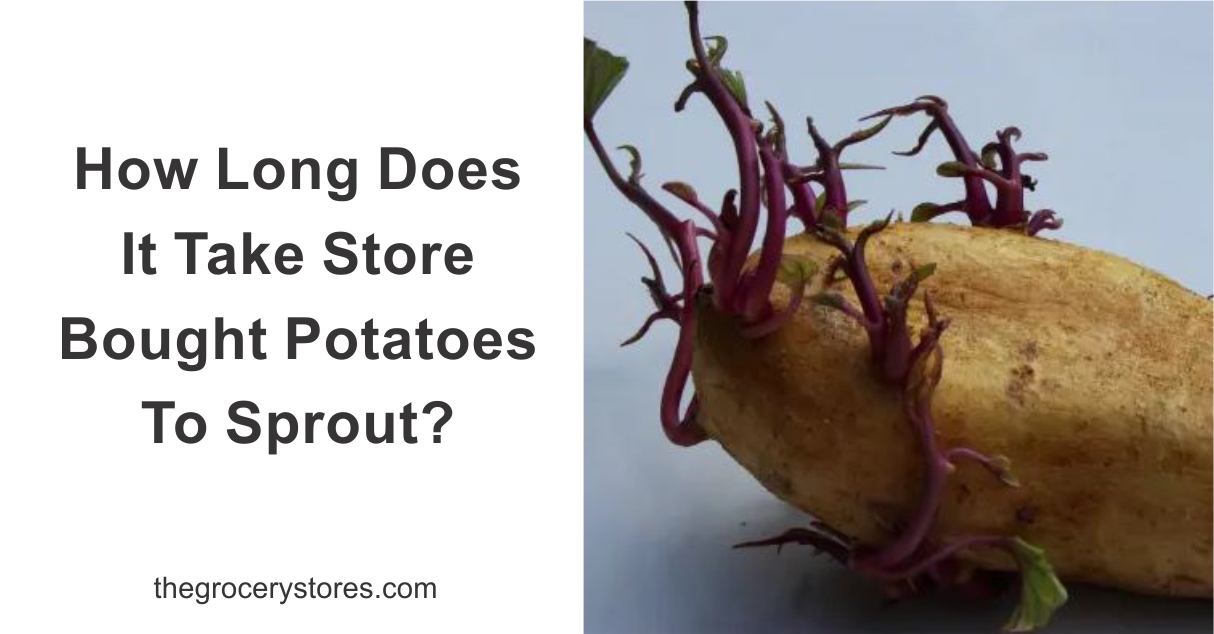Potatoes are known to have a dormancy period of about 4–8 weeks after they’ve been harvested, before they go on to sprout. If you’d like to grow your store-bought potatoes, here are some tips to help you.
Plant your store-bought potatoes in pots or containers: there’s something called potato blight; it is a disease that destroys potato crops. The disease is said to be very strong and its pathogen can survive in the soil even in winters.
Even though there are herbicides you can treat it with, there’s a possibility that it will resist the disease. This is why it is recommended that you plant your store-bought potatoes in pots and containers instead of soil.
Here are the different steps to take when taking part in growing them.
- Start by letting your potatoes sprout. Ensure you keep them in a warm, bright space for a few weeks prior to planting, to encourage sprouting. This process is called chitting.
- Prepare the potatoes for planting: You can decide to cut your sprouted potatoes into different sections to increase their yielding abilities. Cut the potatoes into one sprout per chunk, then allow them to sit in the air for at least 1-3 days. This will give them the opportunity to be slightly hardened and prevent them from getting rotten.
- Prepare the container your potato will be planted inside: Get a big container or a 5-gallon bucket with drainage holes, then place about 5–6 inches of moistened potting soil in the bottom of the container. Fresh potting soil is preferable so that the risk of other existing soil pathogens dwelling in it will be limited. Good potting soil is also vital in preventing damp conditions, which give space to blight and rot, as it drains well.
- You can now go ahead and plant your potatoes: place your potatoes into the bucket or pot and slightly bury them in the soil. Allow about six inches between the potatoes that you’ve put into the soil. Plant them with the sprouts facing upward, out of the soil, then cover them with more soil until they are buried under 1-2 inches.
- Continue adding soil: keep adding soil to the container in order for the potato vines to be properly covered and mostly buried under the soil line. This gives room for the potato to yield greatly. You’d have to continue mounding the soil around the stalks, and it should cover about half of the new growth, which is called hilling.
- Once the level of your soil is just below the top of your container, you can stop the hilling procedure and allow the potato to grow and develop till harvest time. You just keep watering and fertilizing them. Henceforth, place the container in an area that gets at least 6-7 hours of sun each day.
- It’s time for harvest: the potatoes are likely to take about 10 to 20 weeks for the potatoes to be ready to be harvested, depending on the type of potato. You’ll know when it’s ready as leaves and stalks will begin to turn yellow and die.
What triggers potatoes to sprout?
Sprouting is very important, especially during the season of planting. However, you would want them to grow earlier than that.
Potatoes sprout because of some factors such as;
- Exposure to light: lighting from the sub and indoor lighting is one way to trigger sprouts in potatoes.
- Warm temperature: warm temperature will also trigger or cause Sprouting. High temperatures above 50 degrees are likely to make it sprout. However, temperatures higher than 90 degrees will ultimately destroy the potato.
- Moist conditions: moist conditions also cause potatoes to sprout. This is why it is highly recommended that you plant your potatoes in moist soil and ensure you store them in a dry place after harvesting.
How do you get store-bought potatoes to sprout?
So you’ve just gotten yourself some nice potatoes, and you wonder if you could continue their growth in your yard as a plant.
Store-bought potatoes are always protected with a sprout inhibitor to prevent them from sprouting. Hence, it becomes an issue for them to sprout, but oh well, there are a few things you can do to turn back this action.
You can use gibberellic acid to defeat this condition. For your tubers, without scrubbing off any of the skin before going ahead to soak them in gibberellic acid for 24 hours, take them out of the solution and keep them in a warm, well-lit area.
This solution isn’t common among gardeners; farmers are more familiar with it.
Do potatoes need to sprout before planting?
Well, potatoes do not have seeds, so growing them will have to be done differently compared to other vegetables.
Sprouting or chitting will often get your potatoes growing earlier enough and will definitely give better yields.
Potatoes are actually a winter crop, and it’s important that you plant them before your last frost date. Weather levels above 90 degrees can affect the growth of your crop and sometimes kill it.
Take note that chitting or sprouting is best done 6 weeks in advance of your planting date. If the potato sprouts early enough, then you can remove any sprout larger than two. By doing this, the sprout will not be able to grow back, but the potato will be able to focus its stored energy into growing or producing new sprouts just in time for planting.
Actually, a single sprout is needed for a new plant to form. However, potatoes are wired to produce more sprouts in order to increase their chance of surviving.
Can I use store-bought potatoes to plant?
Experts actually disagree on whether store-bought potatoes should be planted or not, while some have said to have planted and harvested them in tubers.
The reason you’re here today isn’t much different from this, to know how to be able to plant store-bought potatoes.
Now, the thing is, if your store-bought potatoes begin to sprout, it’s only one indication that they are plantable. One of the advantages of the store-bought potatoes is that they are readily available, not like seed potatoes, where you’ll have to go through a long process and wait till they are delivered.
Here are the steps to follow to plant store-bought potatoes.
Step 1. Prepare the soil by loosening the soil area to about 10 to twelve inches deep, then mixing a fertilizer high in nitrogen with the soil. Make trenches in the soil about 4 inches deep and then plant your potatoes about 4 inches apart.
Step 2. Water your potato plants, especially during flowering, especially when they are producing tubers.
Step 3. As the plants begin to come out, mound the soil by pushing it up around the stem. When the plants are fully ready, you can go ahead and dig potatoes and harvest them from the raised bed rows, removing any vines.
How do you speed up sprouting potatoes?
Maybe the planting season is almost here and your potato is yet to sprout, so you’re looking for answers towards making it sprout faster. Well, the good news is that it is possible to achieve the feat.
Follow these steps to make your potato sprout faster.
- Put your potatoes in a place that is not too dry. It should be at a temperature of between 45 and 60 Fahrenheit. Put them out in an area where they are exposed to indirect sunlight.
- You can also place onions or apples alongside the potato tubers, to speed up the sprouting process, the potato will be moved to sprout by the gases emitted by the fruit.
- A moist area, rag or damp leaves will also prevent the tubers from becoming wrinkled and dried out.
Do potatoes sprout faster in the dark?
Yes, potatoes do sprout in the dark, but I can not say that they sprout faster in the dark. If you’re sprouting your potatoes before the sprouting season ensues, it’s best to do it in a sunny area where it’s cool and frost free. Light is so necessary for your potatoes to sprout faster.
Gardeners are known to employ the chitting process towards getting potatoes sprouting sooner than they actually would in a garden, which means an earlier harvest.
As an additional bonus, the first early crop is normally harvested before potato blight can become a major concern if you chit your potatoes. Chitting is normally said to begin in late January or February.
It is also advised that you use certified seed potatoes to plant in the garden, because potatoes that you find in the grocery store are likely to have already been sprayed with sprout inhibitor.
However, if you insist on using store-bought potatoes, then you should follow the procedure stated in the subtopic before this to properly get rid of the inhibitor and allow sprouting.

